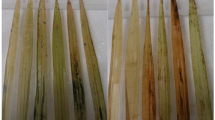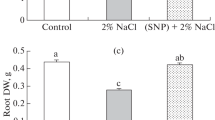Abstract
The aim of this study is to elucidate the influence of the exogenous application of gallic acid (GLA) in alleviating the detrimental effects of salinity (NaCl), osmotic stress (polyethylene glycol; PEG), and their combination in Oryza sativa L. roots. To produce same osmotic potential (−0.5 MPa), 3-week-old rice seedlings were treated with 120 mM NaCl and/or 20 % PEG6000 with/without GLA (0.75 and 1.5 mM) treatments for 72 h. Both alone and combination of stresses decreased growth (RGR) and osmotic potential (Ψ Π). Moreover, stress caused a significant increase in proline (Pro) and hydrogen peroxide (H2O2) contents. Also, Pokkali and IR-28 had higher H2O2-scavenging enzyme activities including catalase (CAT), ascorbate peroxidase (APX), and glutathione reductase (GR) activities in NaCl-treated roots. Only CAT activity was induced in both cultivars with PEG. Therefore, the enhanced levels of lipid peroxidation (thiobarbituric acid reactive substances (TBARS)) were more pronounced under PEG than NaCl. However, GLA significantly mitigated NaCl and/or PEG-induced stress injury. Under salinity, TBARS was lesser in GLA-applied rice that was associated with greater activities of superoxide dismutase (SOD), peroxidase (POX), and APX. GLA in the presence of PEG improved the activities of CAT and POX. According to these findings, GLA alleviated the damaging effects of NaCl and/or PEG (especially under NaCl) by improving the antioxidative system in rice. This is the first study elucidating the effects of GLA on tolerance to salinity, osmotic stress, and their combination in plants.

Pathways for ROS scavenging in plants. Abbreviations: GPX glutathione peroxidase; SOD superoxide dismutase; CAT catalase; APX ascorbate peroxidase; AsA ascorbate; GSH glutathione; DHA dehydroascorbate; DHAR DHA reductase; GR glutathione reductase; GSSG oxidized glutathione; MDA monodehydroascorbate and MDHAR MDA reductase. The graphical abstract was modified from Mittler (Trends Plant Sci 7:405–410, 2002) and Gill and Tuteja (Plant Physiol Biochem 48(12):909–930, 2010).






Similar content being viewed by others
References
Ahmad MSA, Javed F, Ashraf M (2007) Iso-osmotic effect of NaCl and PEG on growth, cations and free proline accumulation in callus tissues of two indica rice (Oryza sativa L.) genotypes. Plant Growth Regul 53:653–663
Basu S, Roychoudhury A, Saha PP, Sengupta DN (2010) Differential antioxidative responses of indica rice cultivars to drought stress. Plant Growth Regul 60:51–59
Bates L, Waldrenn R, Teare I (1973) Rapid determination of free proline for water-stress studies. Plant Soil 39:205–207
Beauchamp C, Fridovich I (1971) Superoxide dismutase: improved assays and an assay applicable to acrylamide gels. Anal Biochem 44:276–287
Beckman CH (2000) Phenolic storing cells: keys to programmed cell death and periderm formation in wilt disease resistance and in general defense responses in plants? Physiol Mol Plant Pathol 57:101–110
Bergmeyer N (1970) Methoden der enzymatischen analyse, vol 1. Akademie Verlag, Berlin
Bolarin MC, Estañ MT, Caro M, Romero-Aranda R, Cuartero J (2001) Relationship between tomato fruit growth and fruit osmotic potential under salinity. Plant Sci 160:1153–1159
Bradford MM (1976) A rapid and sensitive method for the quantization of microgram quantities of protein utilizing the principle of the protein-dye binding. Anal Biochem 72:248–254
Brown CE, Pezeshki SR, DeLaune RD (2006) The effects of salinity and soil drying on nutrient uptake and growth of Spartina alterniflora in a simulated tidal system. Environ Exp Bot 58:140–148
Chagas RM, Silveira JAG, Rafael V, Ribeiro RV, Vitorello VA, Carrer H (2008) Photochemical damage and comparative performance of superoxide dismutase and ascorbate peroxidase in sugarcane leaves exposed to paraquat-induced oxidative stress. Pestic Biochem Physiol 90:181–188
Cha-um S, Kirdmanee C (2009) Effect of osmotic stress on proline accumulation, photosynthetic abilities and growth of sugarcane plantlets (Saccharum officinarum L.). Pak J Bot 40:2541–2552
Cheng DG, Kao CH (2010) Effect of exogenous spermine on polyethylene glycol-induced responses in rice leaves. Crop Environ Bioinform 7:233–242
Chezen O, Hartwig W, Newman PM (1995) The different effects of PEG-6000 and NaCl on leaf development are associated with differential inhibition of root water transport. Plant Cell 18:727–735
Choudhury S, Panda P, Sahoo L, Panda SK (2013) Reactive oxygen species signalling in plants under abiotic stress. Plant Signal Behav 8:236–281
Dat J, Vandenabeele S, Vranová E, Van Montagu M, Inzé D, Breusegem F (2000) Dual action of the active oxygen species during plant stress responses. CMLS Cell Mol Life Sci 57:779–795
Demiral T, Turkan I (2005) Comperative lipid peroxidation, antioxidant defense systems and proline content in roots of two rice cultivars differing in salt tolerance. Environ Exp Bot 53:247–257
Desikan R, Hancock JT, Neill SJ (2003) Oxidative stress signaling. In: Hirt H, Shinozaki K (eds) Plant responses to abiotic stress: topic in current genetics. Springer-Berlag, Berlin, Heidelberg, pp 121–148
Duh P (1999) Antioxidant activity of water extract of four Harng Jyur (Chrysanthemum morifolium Ramat.) varieties in soybean oil emulsion. Food Chem 66:471–476
Foyer CH, Halliwell B (1976) The presence of glutathione and glutathione reductase in chloroplast: a proposed role in ascorbic acid metabolism. Planta 133:21–25
Gangopadhyay G, Basu S, Gupta S (1997) In vitro selection and physiological characterization of NaCl and mannitol adapted callus lines in Brassica juncea. Plant Cell Tissue Organ Cult 50:161–169
Gill SS, Tuteja N (2010) Reactive oxygen species and antioxidant machinery in abiotic stress tolerance in crop plants. Plant Physiol Biochem 48(12):909–930
Herzog V, Fahimi H (1973) Determination of the activity of peroxidase. Anal Biochem 55:554–562
Hsu YT, Kao CH (2007) Toxicity in leaves of rice exposed to cadmium is due to hydrogen peroxide accumulation. Plant Soil 298:231–241
Hunt R, Causton DR, Shipley B, Askew AP (2002) A modern tool for classical plant growth analysis. Ann Bot 90:485–488
Hussain MI, Gonzalez L, Reigosa MJ (2011) Allelopathic potential of Acacia melanoxylon R. Br. on the germination and root growth of native species. Weed Biol Manag 11:18–28
Jiang Y, Huang B (2001) Drought and heat stress injury in two cool season turf grasses in relation to antioxidant metabolism and lipid peroxidation. Crop Sci 41:436–442
Kader MA, Seidel T, Golldack D, Lindberg S (2006) Expressions of OsHKT1, OsHKT2 and OsVHA are differentially regulated under NaCl stress in salt-sensitive and salt-tolerant rice (Oryza sativa L.) cultivars. J Exp Bot 57:4257–4268
Kirakosyan A, Seymour E, Kaufman BP, Warber S, Bolling S, Chang CS (2003) Antioxidant capacity of polyphenolic extracts from leaves of Crataegus laevigata and Crataegus monogyna (Hawthorn) subjected to drought and cold stress. J Agric Food Chem 51:3973–3976
Ksouri R, Megdiche W, Debez A, Falleh H, Grignon C, Abdelly C (2007) Salinity effects on polyphenol content and antioxidant activities in leaves of the halophyte Cakile maritima. Plant Physiol Biochem 45:244–249
Laemmli UK (1970) Cleavage of structural proteins during the assembly of the head of bacteriophage T4. Nature 227:680–685
Lehman ME, Blum U (1999) Evaluation of ferulic acid uptake as a measurement of allelochemical dose: effective concentration. J Chem Ecol 25:2585–2600
Liu ZJ, Guo YK, Bai JG (2010) Exogenous hydrogen peroxide changes antioxidant enzyme activity and protects ultrastructure in leaves of two cucumber ecotypes under osmotic stress. J Plant Growth Regul 29:171–183
Madhava Rao KV, Sresty TVS (2000) Antioxidative parameters in the seedlings of pigeon pea [Cajanus cajan (L.) Millspaugh] in response to Zn and Ni stresses. Plant Sci 157:113–128
Menezes-Benavente L, Teixeira FK, Kamei CLA, Margis-Pinheiro M (2004) Salt stress induces altered expression of genes encoding antioxidant enzymes in seedlings of a Brazilian indica rice (Oryza sativa L.). Plant Sci 166:323–331
Michalak A (2006) Phenolic compounds and their antioxidant activity in plants growing under heavy metal stress. Pol J Environ Stud 15:523–530
Miller G, Shulaev V, Mittler R (2008) Reactive oxygen signaling and abiotic stress. Physiol Plant 133:481–489
Mishra RPN, Singh RK, Jaiswal HK, Kumar V, Maurya S (2006) Rhizobium mediated induction of phenolics and plant growth promotion in rice (Oryza sativa L.). Curr Microbiol 52:383–389
Mittler R (2002) Oxidative stress, antioxidants and stress tolerance. Trends Plant Sci 7:405–410
Mittler R (2006) Abiotic stress, the field environment and stress combination. Trends Plant Sci 11:15–19
Mittler R, Vanderauwera S, Gollery M, Van Breusegem F (2004) Reactive oxygen gene network of plants. Trends Plant Sci 9:490–498
Mittova V, Guy M, Tal M, Volokita M (2002) Response of the cultivated tomato and its wild salt-tolerant relative Lycopersicon pennellii to salt dependent oxidative stress: increased activities of antioxidant enzymes in root plastids. Free Radic Res 36:195–202
Nakano Y, Asada K (1981) Hydrogen peroxide is scavenged by ascorbate-specific peroxidase in spinach chloroplasts. Plant Cell Physiol 22:867–880
Newton RJ, Puryear JD, Sen S (1989) Water status and growth of loblolly pine (Pinus taeda L.) callus. Plant Cell Tissue Org Cult 16:3–13
Noctor G, Foyer CH (1998) Ascorbate and glutathione: keeping active oxygen under control. Annu Rev Plant Physiol Plant Mol Biol 49:249–279
Pokorny J (2001) Introduction. Pokorny J, Yanishlieva N, Gordon MH (eds) Antioxidants in food: practical applications. Cambridge, pp 1–3
Qu XH, Wang JG (2008) Effect of amendments with different phenolic acids on soil microbial biomass, activity, and community diversity. Appl Soil Ecol 39:172–179
Rizhsky L, Liang H, Shuman J, Shulaev V, Davletova S, Mittler R (2004) When defense pathways collide. The response of Arabidopsis to a combination of drought and heat stress. Plant Physiol 134:1683–1696
Seevers FM, Daly JM, Catedral FF (1971) The role of peroxidase isozymes in resistance to wheat stem rust. Plant Physiol 48:353–360
Sgherri C, Cosi E, Navari-Izzo F (2003) Phenols and antioxidative status of Raphanus sativus grown in copper excess. Physiol Plant 118:21–28
Sucre B, Suárez N (2011) Effect of salinity and PEG-induced water stress on water status, gas exchange, solute accumulation, and leaf growth in Ipomoea pes-caprae. Environ Exp Bot 70:192–203
Vitória AP, Lea PJ, Azevedo RA (2001) Antioxidant enzymes responses to cadmium in radish tissues. Phytochem 57:701–710
Wang WB, Kim YH, Lee HS, Kim KY, Deng XP, Kwak SS (2009) Analysis of antioxidant enzyme activity during germination of alfalfa under salt and drought stresses. Plant Physiol Biochem 4:570–577
Wang Y, Hu J, Qin G, Cui H, Wang Q (2012) Salicylic acid analogues with biological activity may induce chilling tolerance of maize (Zea mays) seeds. Botany 90:845–855
Winkel-Shirley B (2002) Biosynthesis of flavonoids and effects of stress. Curr Opin Plant Biol 5:218–223
Woodbury W, Spencer AK, Stahman MA (1971) An improved procedure for using ferricyanide for detecting catalase isozymes. Anal Biochem 44:301–305
Acknowledgments
Financial support for this work was provided by Necmettin Erbakan University Scientific Research Projects Coordinating Office (project number: 121215001).
Conflict of interest
The authors have no conflicts of interests to declare.
Author information
Authors and Affiliations
Corresponding author
Additional information
Responsible editor: Philippe Garrigues
Rights and permissions
About this article
Cite this article
Ozfidan-Konakci, C., Yildiztugay, E. & Kucukoduk, M. Upregulation of antioxidant enzymes by exogenous gallic acid contributes to the amelioration in Oryza sativa roots exposed to salt and osmotic stress. Environ Sci Pollut Res 22, 1487–1498 (2015). https://doi.org/10.1007/s11356-014-3472-9
Received:
Accepted:
Published:
Issue Date:
DOI: https://doi.org/10.1007/s11356-014-3472-9




